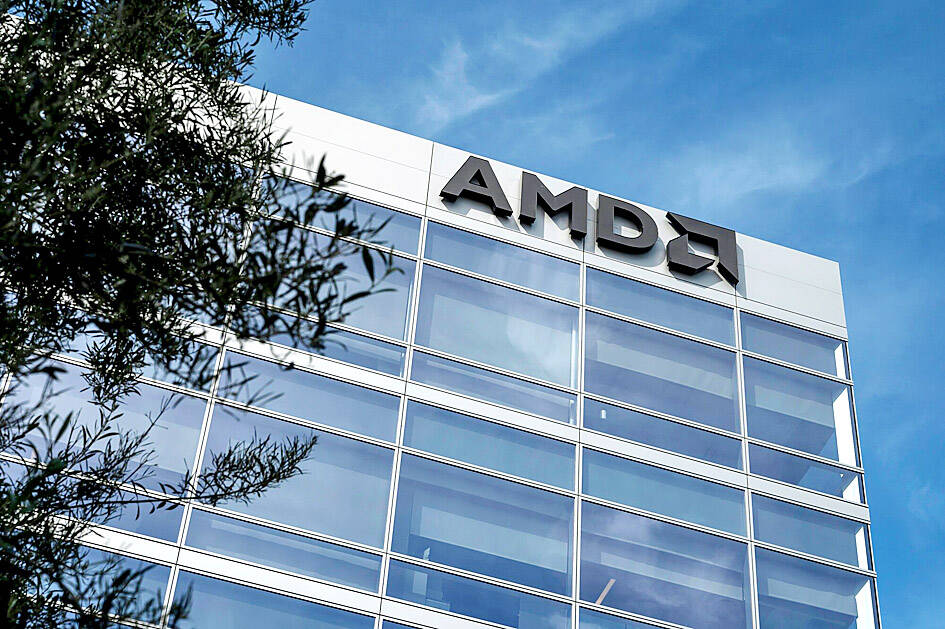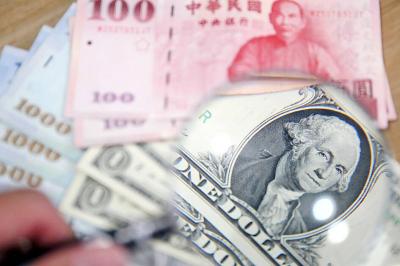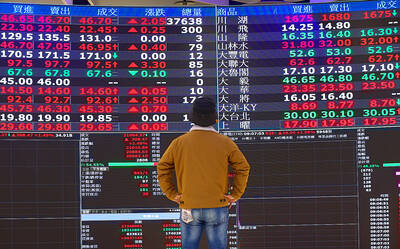Advanced Micro Devices Inc (AMD), the second-biggest maker of computer processors, on Tuesday gave a lukewarm revenue forecast for the current period, weighed down by lackluster demand for chips used in video game hardware.
Second-quarter revenue would be approximately US$5.7 billion, the company said in a statement.
That compares with an average analyst estimate of US$5.72 billion.

Photo: Bloomberg
AMD said that its gross margin would be about 53 percent in the second quarter, matching predictions.
Revenue from AMD’s gaming division fell well short of projections in the first quarter, but the company is expecting to get a boost from a push into artificial intelligence (AI) accelerators — Nvidia Corp-style chips that help develop chatbots and other AI tools.
The company has projected that its new MI300 products would generate as much as US$3.5 billion of revenue this year.
“This is an incredibly exciting time for the industry as widespread deployment of AI is driving demand for significantly more compute across a broad range of markets,” AMD chief executive officer Lisa Su (蘇姿丰) said in the statement.
The AMD report follows a downbeat forecast last week from Intel Corp, which said it expects demand to remain sluggish in the first half of the year, but AMD is still expecting growth in the range of 6 percent in the current quarter, better than the roughly flat projection of its larger rival.
First-quarter earnings per share were US$0.62, excluding some items, on revenue of US$5.47 billion. That performance compared with estimated earnings per share of US$0.61 and US$5.45 billion in sales.
AMD’s PC chip division had revenue of about US$1.4 billion, compared with a US$1.29 billion estimate.
Data center sales came in at US$2.3 billion, in line with the average projection.
Meanwhile, gaming computer-related revenue was US$922 million. Analysts had expected sales of US$965.5 million.
Like Intel, AMD still gets most of its revenue from PC and server microprocessors. The once-solid server market has been less reliable because operators of data centers have plowed much of their budgets into Nvidia chips — the very area AMD is now making its own play for.
AMD also competes with Nvidia in the market for graphics processors that improve the images in video games. It is the biggest rival of Intel in both server and PC processors — as well as in programmable logic chips, which can be reconfigured with software after they are installed, and it supplies Microsoft Corp and Sony Group Corp with the main component in their game consoles.
Separately, Super Micro Computer Inc also on Tuesday reported quarterly sales that fell slightly short of estimates. The results disappointed investors who had sky-high expectations that the server maker’s business would benefit from AI-related demand.
Revenue in the March quarter climbed to US$3.85 billion, the company said in a statement. That’s just below the consensus estimate of US$3.86 billion, according to data compiled by Bloomberg. Profit, excluding some items, was US$6.65 per share, ahead of the US$5.58 expected by Wall Street analysts.
A jump in demand for the equipment that powers artificial intelligence training and applications has helped drive sales at Super Micro, which makes data center servers. Growth rates at the San Jose, California-based company have climbed higher in recent quarters on the back of deals with large corporations and an improving supply of high-powered chips.
Chief executive officer Charles Liang (梁見後) said in a statement that the company should “continue gaining market share” as new products are released.
Revenue in the quarter ending in June will be US$5.1 billion to US$5.5 billion, the company said. Analysts, on average, projected US$4.73 billion, according to data compiled by Bloomberg. Profit, excluding some items, will be as much as US$8.42 per share, compared with an average estimate of US$6.97.

The US dollar was trading at NT$29.7 at 10am today on the Taipei Foreign Exchange, as the New Taiwan dollar gained NT$1.364 from the previous close last week. The NT dollar continued to rise today, after surging 3.07 percent on Friday. After opening at NT$30.91, the NT dollar gained more than NT$1 in just 15 minutes, briefly passing the NT$30 mark. Before the US Department of the Treasury's semi-annual currency report came out, expectations that the NT dollar would keep rising were already building. The NT dollar on Friday closed at NT$31.064, up by NT$0.953 — a 3.07 percent single-day gain. Today,

‘SHORT TERM’: The local currency would likely remain strong in the near term, driven by anticipated US trade pressure, capital inflows and expectations of a US Fed rate cut The US dollar is expected to fall below NT$30 in the near term, as traders anticipate increased pressure from Washington for Taiwan to allow the New Taiwan dollar to appreciate, Cathay United Bank (國泰世華銀行) chief economist Lin Chi-chao (林啟超) said. Following a sharp drop in the greenback against the NT dollar on Friday, Lin told the Central News Agency that the local currency is likely to remain strong in the short term, driven in part by market psychology surrounding anticipated US policy pressure. On Friday, the US dollar fell NT$0.953, or 3.07 percent, closing at NT$31.064 — its lowest level since Jan.

The New Taiwan dollar and Taiwanese stocks surged on signs that trade tensions between the world’s top two economies might start easing and as US tech earnings boosted the outlook of the nation’s semiconductor exports. The NT dollar strengthened as much as 3.8 percent versus the US dollar to 30.815, the biggest intraday gain since January 2011, closing at NT$31.064. The benchmark TAIEX jumped 2.73 percent to outperform the region’s equity gauges. Outlook for global trade improved after China said it is assessing possible trade talks with the US, providing a boost for the nation’s currency and shares. As the NT dollar

The Financial Supervisory Commission (FSC) yesterday met with some of the nation’s largest insurance companies as a skyrocketing New Taiwan dollar piles pressure on their hundreds of billions of dollars in US bond investments. The commission has asked some life insurance firms, among the biggest Asian holders of US debt, to discuss how the rapidly strengthening NT dollar has impacted their operations, people familiar with the matter said. The meeting took place as the NT dollar jumped as much as 5 percent yesterday, its biggest intraday gain in more than three decades. The local currency surged as exporters rushed to